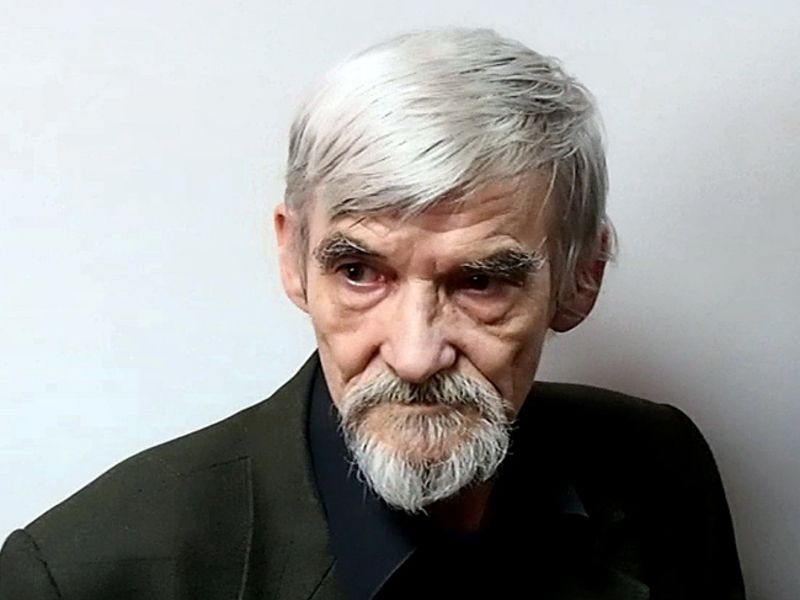The Conviction of the Historian Yuri Dmitriev and the Suicide of the Journalist Irina Slavina Reveal the Injustice of the Putin System.
by Enzo Reale (November 2020)

Yuri Dmitriev, photo by Igor Podgorny
I have long wanted to write about Yuri Dmitriev. His case is not a simple story of abuse of power and summary justice in Vladimir Putin’s Russia, but a symbol of the eternal tension between common man and authority, which has always blown like an icy wind on the immense esplanades of the country until it became collective tragedy in Soviet times.
Dmitriev, an orphan, a father, and a passionate historian, seems to come out of a Chekhov’s tale to plunge himself between the frowning eyebrows of a former KGB agent, who assumed the task of restoring the national pride buried in the rubble of Communism, through a counterfeit rethoric and a selective control of the past. Individual aspirations, search for truth, shared memory, power: the future of today’s Russia is played out among these four (often opposite) poles. Yuri Dmitriev belongs to the first three. Vladimir Putin to the fourth.
In 1997, after years of research, Dmitriev and colleagues from the St Petersburg Memorial Foundation (which has been collecting, cataloging and protecting evidence of Soviet repression since the late 1980s), discovered in a forest in the northwestern region of Karelia an immense mass grave with the remains of 9,000 victims of the Stalinist terror. Those were the golden years of Russian historiography, just after the fall of the Communist regime, when the archives were opened and new opportunities of shedding light on the tragedies of the totalitarian period materialized. The locality, known now as Sandarmokh, became the scene of mass executions between October 1937 and December 1938: the victims were 3500 inhabitants of Karelia, another 4500 were prisoners working on the construction of the Baltic Sea Canal, and 1,111 were prisoners of the Solovki concentration camp, one of the most inhospitable and isolated Soviet lagers, defined by Solzhenitsyn as “the mother of the Gulag.” The latter group corresponded to the percentage of executable persons requested by the NKVD (Stalin secret police) from the penitentiary center, according to the directives of the Communist Party that assigned these objectives (as mentioned in their deadly five-year plan). The condemned were made to kneel in front of a mass grave and finished off with a shot in the back of the head—the same method that would be used two years later in the Katyn forest against thousands of Polish officers. It was a trademark of Stalinism. Dmitriev’s work recently merged into the book Sandarmokh: A Place of Memory, where he discovered the identities of at least five thousand people killed in the extermination camp and identified the perpetrators of the executions.
On 13 December 2016, Yuri Dmitriev was arrested on charges of child pornography. On his computer, police found naked pictures of his then-eleven-year-old adopted daughter, Natasha, which were taken to monitor her growth as was medically advised. He spent 13 months in prison before being acquitted at trial. Two months later, in June 2018, the historian was rearrested on charges of having sexually abused the same child who by then he had not seen for two years. The prosecution was based on the testimony of the Natasha’s grandmother, who had abandoned her in an orphanage before being adopted by the Dmitriev family. The trial ended with Dmitriev being sentenced to three and a half years. But the authorities were not satisfied and so appealed to the Supreme Court of Karelia which, a few weeks ago, decided to lock him up for another ten years in a maximum-security penal colony: Dmitriev is 64 years old. This is a lifetime sentence.
The fury and persecution against an innocent man, whose only fault was to shed light on the recent history of his country, is the logical consequence of the legal squeeze against NGOs decided by Putin in 2012, the infamous law that included them in the category of “foreign agents.” Under this legislation, both the St. Petersburg Memorial Foundation and the Sakharov Center have been sanctioned several times over the years. But there’s more. After a decade in which the historians’ work on the Gulag system and on the repressions in Soviet Union were essentially ignored, during the second part of Putin’s presidential term (starting from 2010), the State decided to assume the role of interpreter of the official history, passing from a passive attitude of non-collaboration to an active one of overlapping and intimidation towards independent researchers. Access to archives was limited, surveillance increased, justice used as a weapon against non-homologated voices questioning the national discourse promoted by the Government, where even the totalitarian past must be re-read in a positive light if functional to the objectives of development and consolidation of the “Russian homeland.” For that reason, one of the amendments to the Constitution recently approved by referendum (art. 67) literally assigns to the State—and not to historians—the task of “ensuring the protection of historical truth;” and for the same reason in 2016, while the accusations against Dmitriev were being fabricated, the government decided to send a team of soldiers to Sandarmokh with the task of exhuming the remains of some corpses, in order to prove that they were not victims of Stalinism but instead Red Army personnel killed by Finnish soldiers during the 1939-40 conflict.
The manipulation and removal of the past for the political interests of the present precisely define the Putin regime and the new Russian nationalism. From the Gulag to the Second World War, there is no historical field that the government does not undertake to adapt to current circumstances and conveniences. The reasons are profound and would deserve a separate study: surely, substantial continuity between Soviet and Russian institutions plays a role in this fossilization of memory (at the time of the Soviet Union dissolution the nature of the regime changed but the supporting structures of the system served as platform for the newcomers), as well as the absence of a real collective exercise of analysis, judgment and reconciliation on the totalitarian era. The revenge of the State against Dmitriev is an unequivocal sign of this bad conscience which, moreover, indicates a qualitative leap in the Kremlin’s strategy: the passage from propaganda to open repression.
Last May, 150 cultural personalities signed an open letter to the court where the trial took place, declaring their support for the historian against “the unjust accusations against him.” In his final speech before the verdict (which I highly recommend reading in full), Dmitriev explains his concept of patriotism, that cannot be limited to the military parades of May 9 in honor of the fallen in the Great Patriotic War but must also include the memory of the victims of the internal war that the Soviet state waged against its citizens: “I try to recover their names because only memory can make a person really such.” Let’s make known the names of Yuri Dmitriev and Sandarmokh.
 I also want to write some words about Irina Slavina (Right), journalist, from Nizhny Novgorod, a charming town on the Volga River, in the center of European Russia. At six in the morning on October 1, the police and various special security forces arrived to search her home. They looked for evidence of her activities with an opposition group that reports to Mikhail Khodorkovsky, a former oligarch now in exile after a long judicial persecution. It was not the first time that the authorities targeted her for participating in some protests and for editing this information site (http://koza.press/). This was the last time, however. The day after that umpteenth humiliation, she wrote a last message on Facebook: “Blame Russian Federation for my death.” Then she left the house and went to sit on a bench in front of the local section of the Ministry of the Interior, among three bronze statues dedicated to the police and then set herself on fire. A passerby tried to approach to put out the flames but she kicked him away. She wanted to die and wanted to do so in a bonfire, an unmistakable symbol of protest and dignity. There is a one-minute video that captures her agony and it is a heartbreaking sequence. The fire quickly envelops her, lifts her up, throws her to the ground and crumpled her up, like a disintegrating sheet of paper. Irina Slavina was the mother of a teenager who, a few hours after the events, showed up at the scene of the suicide with a complaint placard: “While my mother was burning, you remained silent.” That Nizhny Novgorod bench is now full of bouquets of flowers. But the name of Irina Slavina is doomed to oblivion. Memory, in 21st century Russia, has been confiscated by the State.
I also want to write some words about Irina Slavina (Right), journalist, from Nizhny Novgorod, a charming town on the Volga River, in the center of European Russia. At six in the morning on October 1, the police and various special security forces arrived to search her home. They looked for evidence of her activities with an opposition group that reports to Mikhail Khodorkovsky, a former oligarch now in exile after a long judicial persecution. It was not the first time that the authorities targeted her for participating in some protests and for editing this information site (http://koza.press/). This was the last time, however. The day after that umpteenth humiliation, she wrote a last message on Facebook: “Blame Russian Federation for my death.” Then she left the house and went to sit on a bench in front of the local section of the Ministry of the Interior, among three bronze statues dedicated to the police and then set herself on fire. A passerby tried to approach to put out the flames but she kicked him away. She wanted to die and wanted to do so in a bonfire, an unmistakable symbol of protest and dignity. There is a one-minute video that captures her agony and it is a heartbreaking sequence. The fire quickly envelops her, lifts her up, throws her to the ground and crumpled her up, like a disintegrating sheet of paper. Irina Slavina was the mother of a teenager who, a few hours after the events, showed up at the scene of the suicide with a complaint placard: “While my mother was burning, you remained silent.” That Nizhny Novgorod bench is now full of bouquets of flowers. But the name of Irina Slavina is doomed to oblivion. Memory, in 21st century Russia, has been confiscated by the State.
«Previous Article Table of Contents Next Article»
_________________________________
Enzo Reale is an Italian journalist living in Barcelona who writes about international politics. His articles have appeared in Atlantico Quotidiano, New English Review, L’Opinione, and Il Foglio and he is the author of 1972 (I posti della ragione erano tutti occupati). You can follow him on Twitter at @1972book.
NER on Twitter @NERIconoclast
- Like
- Digg
- Del
- Tumblr
- VKontakte
- Buffer
- Love This
- Odnoklassniki
- Meneame
- Blogger
- Amazon
- Yahoo Mail
- Gmail
- AOL
- Newsvine
- HackerNews
- Evernote
- MySpace
- Mail.ru
- Viadeo
- Line
- Comments
- Yummly
- SMS
- Viber
- Telegram
- Subscribe
- Skype
- Facebook Messenger
- Kakao
- LiveJournal
- Yammer
- Edgar
- Fintel
- Mix
- Instapaper
- Copy Link








